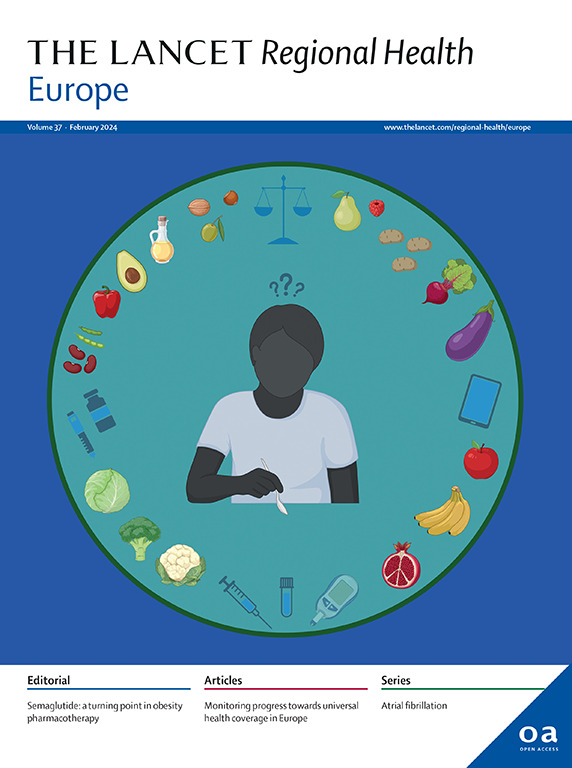根据年龄、性别和国家收入水平的脑出血发病率、病死率和功能转归:一项系统回顾和荟萃分析
IF 13.6
Q1 HEALTH CARE SCIENCES & SERVICES
引用次数: 0
摘要
背景:脑出血(ICH)约占全世界所有中风的28%。脑出血病死率高,只有少数幸存者能恢复独立生活。在过去的几十年里,人口结构的变化以及危险因素的流行和管理的变化可能影响了发病率。卒中单元的广泛实施和总体护理的改善可能影响了病死率和转归。我们的目的是根据年龄、性别和国家收入水平更新有关脑出血发病率、病死率和功能转归的证据。方法:从2008年到2023年4月,我们系统地检索了PubMed和Embase关于首次脑出血发病率、病死率或功能结局的前瞻性基于人群的研究。我们排除了通过影像学或尸检证实的病例少于80%的研究。研究的质量是基于用例发现方法来评估的。我们使用了基于逆方差的随机效应荟萃分析,汇总了粗发病率、1个月病死率以及个体研究作者定义的3、6或12个月后功能预后良好的患者百分比。使用加权线性元回归评估时间趋势。构建漏斗图来研究发表偏倚。该审查已在PROSPERO注册(CRD42023413314)。结果:我们确定了70项符合条件的研究,描述了来自26个不同国家的19,470例脑出血患者。其中,62项研究报告了粗发病率,41项报告了病死率,10项报告了功能结局。总粗发病率为29.2 / 100000人-年(95% CI 23.3-36.4;i2 = 100%)。女性的发病率低于男性,并随着年龄的增长而增加。发病率在中低收入国家最高,其次是高收入国家和中高收入国家。1个月病死率为35.5% (95% CI 32.3-38.9;i2 = 90%)。3-12个月后功能预后良好(9项研究中mRS 0-2, 1项研究中mRS 0-3)的患者百分比为31.2% (95% CI 24.7-38.6;i2 = 76%)。我们没有发现发病率、病死率或功能结局的时间趋势。解释:我们的研究结果证明了脑出血的持续高负担和破坏性后果,强调了更好的预防策略和急性治疗的必要性。资金:没有。本文章由计算机程序翻译,如有差异,请以英文原文为准。
Incidence, case fatality, and functional outcome of intracerebral haemorrhage, according to age, sex, and country income level: a systematic review and meta-analysis
Background
Intracerebral haemorrhage (ICH) accounts for approximately 28% of all strokes worldwide. ICH has a high case fatality, and only few survivors recover to independent living. Over the past decades, demographic changes, and changes in prevalence and management of risk factors may have influenced incidence. Widespread implementation of stroke units and improved care in general may have affected case fatality and outcome. We aimed to update the evidence on incidence, case fatality, and functional outcome of ICH, according to age, sex, and country income level.
Methods
We systematically searched PubMed and Embase from 2008 to April 2023 for prospective population-based studies on incidence, case fatality, or functional outcome of first-ever ICH. We excluded studies in which less than 80% of cases was confirmed with imaging or autopsy. Quality of the studies was assessed based on the used case finding methods. We used inverse variance-based random-effects meta-analyses to pool the crude incidence, case fatality at 1 month, and the percentage of patients with good functional outcome after 3, 6, or 12 months, as defined by the authors of the individual studies. Time trends were assessed using weighted linear meta-regression. Funnel plots were constructed to study publication bias. The review was registered on PROSPERO (CRD42023413314).
Findings
We identified 70 eligible studies, describing 19,470 ICH patients from 26 different countries. Of these, 62 studies reported on crude incidence, 41 on case fatality, and 10 on functional outcome. Overall crude incidence was 29.2 per 100,000 person-years (95% CI 23.3–36.4; I2 = 100%). Incidence was lower in women than in men and increased with age. Incidence was highest in lower-middle income countries, followed by high and upper-middle income countries. Case fatality at 1 month was 35.5% (95% CI 32.3–38.9; I2 = 90%). The percentage of patients with good functional outcome (mRS 0–2 in nine studies, mRS 0–3 in one) after 3–12 months was 31.2% (95% CI 24.7–38.6; I2 = 76%). We found no time trends in incidence, case fatality, or functional outcome.
Interpretation
Our results demonstrate the persistently high burden and devastating consequences of ICH, stressing the need for better preventive strategies and acute treatments.
Funding
None.
求助全文
通过发布文献求助,成功后即可免费获取论文全文。
去求助
来源期刊

Lancet Regional Health-Europe
Multiple-
CiteScore
19.90
自引率
1.40%
发文量
260
审稿时长
9 weeks
期刊介绍:
The Lancet Regional Health – Europe, a gold open access journal, is part of The Lancet's global effort to promote healthcare quality and accessibility worldwide. It focuses on advancing clinical practice and health policy in the European region to enhance health outcomes. The journal publishes high-quality original research advocating changes in clinical practice and health policy. It also includes reviews, commentaries, and opinion pieces on regional health topics, such as infection and disease prevention, healthy aging, and reducing health disparities.
 求助内容:
求助内容: 应助结果提醒方式:
应助结果提醒方式:


